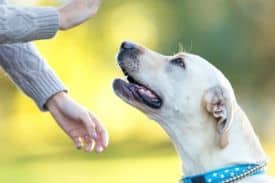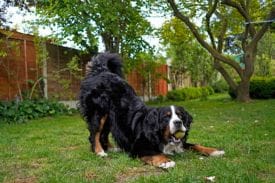Have you ever wondered why your pup seems to be able to understand exactly what you’re saying? Or why can they sense something isn’t right even before you do? It’s because dogs have a secret language all their own.
They communicate with us and other animals using body language, vocalizations, and play behavior. Learning the secret language of dogs can help us better understand our furry friends and create lasting bonds between us.
It may seem like a coincidence that we are so good at understanding each other, but it’s no accident. Dogs have an innate desire to serve others, whether by being protective or just providing companionship. By learning to read their secret language, we can tap into this inner drive and provide them with the love and care they need.
So join us as we uncover the mysteries behind canine communication!
Key Takeaways
- Dogs have a secret language, including body language, vocalizations, and play behavior.
- Barking, eye contact, body language, and tail wagging are key elements of canine communication that indicate emotions and intentions.
- Play behavior is a form of communication and bonding between dogs and humans and includes behaviors such as sniffing and play fighting.
- Understanding your pup’s social hierarchy is important for establishing healthy boundaries and preventing aggressive behavior.
Basics of Dog Communication

Dogs’ communication is essential for understanding them, and it’s easier than you think: listen closely, and you’ll pick up on the basics in no time!
Barking sounds are one of the most common forms of canine communication. Barking can communicate anything from joy to fear, depending on the pitch and intensity. Please understand your dog’s barking patterns to understand their moods better.
Eye contact is another way dogs communicate with humans and other animals. Dogs that maintain eye contact tend to be more confident, while those who break away from direct eye contact might feel anxious or afraid. Be mindful of your pup’s body language when they make eye contact with you or others since this will give you a better idea of their feelings.
You can learn more about your four-legged friend’s feelings and intentions by being aware of these two key elements of canine communication- barking sounds and eye contact. It may take some time for both parties to understand each other, but if you pay close attention, eventually, you’ll start picking up on subtle cues that let you know exactly what your pup is trying to say!
When it comes down to it, understanding dogs isn’t complicated; it just takes patience, practice, and plenty of love!
Body Language
You can learn a lot about how a dog feels by observing its body language. Posture, facial expressions, movements, and tail wagging are all important indicators of canine communication.
Paying attention to these cues can help you better understand your pup and foster a stronger connection between you.
Posture, Facial Expressions, and Movements
You can better understand canine communication by observing a dog’s posture, facial expressions, and movements.
Pay attention to the position of the tail, ears, and eyes when looking for cues. A seat held high could indicate confidence or alertness, while a tucked tail may signal fear or submission. Ears up could tell that the dog is attentive, but ears laid back might reveal discomfort or anxiety.
The shape of the eyes and brow can also tell you how your pup is feeling. If they’re wide open with raised eyebrows, it may mean curiosity or excitement, whereas narrowed eyes and furrowed brows can point to aggression or anger.
Facial expressions such as lip-licking, “smiling”(when a pup shows teeth), and yawning can also tell you how your dog feels in any situation.
To further understand what your pup is trying to say, take note of their movements. Do they seem hesitant when approaching something new? Are they jumping around excitedly?
These elements will help you decipher your furry friend’s secret language!
Tail Wagging
Tail wagging is often considered a sign of happiness in dogs but can indicate various emotions.
For example, if your pup’s tail wags more to the right side of its body, this could be a sign that they’re feeling relaxed and content; however, if its tail moves to the left, it may suggest fear or anxiety.
Tail wagging also has breed differences: some breeds are known for wagging lower than others, while some will mix in sniffing behavior when trying to express something important.
Additionally, different breeds tend to have different lengths and shapes of tails which can affect how far the bottom swings when it’s being wagged.
Understanding these nuances can help you better interpret your pup’s emotions and provide them with the support they need.
Vocalizations

Dogs’ vocalizations are a unique way of communicating their innermost emotions- so listen and don’t miss out! From barking sounds to whining noises, each vocalization has its meaning.
Growls can indicate fear or aggression, while whines may suggest that the dog is uncomfortable or anxious. A howl may be a sign of loneliness or boredom. By learning your pup’s vocalizations, you can better understand what they need and feel at any moment.
In addition to growls, barks, and other basic sounds, dogs also use different pitches and tones of voice to convey emotion. A high-pitched bark may indicate excitement or joy, while a low-pitched growl could mean the dog feels threatened or defensive. Dogs also have various ‘conversational’ noises that they use to communicate, such as yips, yaps, grunts, and more.
Pet owners must pay attention to their canine companion’s vocalizations to know when something isn’t quite right with them emotionally or physically. Knowing your pup’s language will help you create a stronger bond between you two – not only will you understand them better, but they’ll also learn to communicate with you too!
Play Behavior

Now that you understand dogs’ vocalizations let’s move on to one of their most beloved activities: play behavior. Play is a behavior in which two or more dogs (or humans!) enjoyably interact with each other. It’s important to remember that play is not aggression but communication and bonding between the participants. Understanding your pup’s play habits can give you insight into what makes them tick!
To help you better understand canine play behavior, the table below outlines some common behaviors associated with playful interactions.
| Sniffing Behavior | Play Fighting | |
|---|---|---|
| What? | Dogs sniff each other while playing to get to know each other better | Two dogs engage in mock fighting by tussling and nipping at each other, usually without causing harm |
| Why? | To learn about the other dog’s scent and identity | To practice social skills such as self-control and dominance |
| How? | By getting close enough for their noses to touch one another’s fur | By taking turns being dominant or submissive during the fight |
It’s easy to see why these playful behaviors are so important for pups! They allow them to express themselves, practice social skills, bond with others, and even have fun! So next time you observe your dog engaging in any of these activities, take it as a sign that they feel comfortable enough around you to let loose and show their true personality.
Social Hierarchy
Understanding your pup’s social hierarchy is like peeling an onion: there are multiple layers to uncover. Dogs are pack animals and have a strong instinct to understand their place in the pack. They exhibit scent marking and territorial defense when another canine enters their home or space.
It’s important to recognize these signs to understand better where your pup stands in the pecking order of their furry family. Although it may seem daunting, decoding your pup’s social hierarchy doesn’t have to be difficult if you pay attention to subtle cues and body language clues.
One way to decipher social ranking is by observing how other dogs interact; this will give you a better idea of where your pup stands compared to others. You can even get involved by introducing new members into the group through controlled interactions, which allows everyone involved – both canine and human – to establish healthy boundaries that benefit all parties involved.
When dealing with social hierarchies amongst dogs, owners must not let any particular dog become dominant over another, as this could lead to aggressive behavior from both sides. By being mindful of this dynamic, owners can ensure that all puppies within their household remain happy and content. After all, isn’t that our ultimate goal?
Frequently Asked Questions
How can I tell if my dog is happy?
You can tell if your dog is happy by observing its behavior. Positive reinforcement and socializing habits will help your pup feel content and secure. Look for signs like tail wagging, relaxed body posture, and active play — these are all indicators that your furry friend feels good!
What is the best way to train my dog?
Train your pup with positive reinforcement and a reward system! Create an engaging atmosphere by praising them when they do something correctly. Start small, build up, and have fun – you’ll be amazed at what your dog can learn!
How do I know if my dog is feeling sick or in pain?
Look out for changes in behavior, such as lethargy or aggression. Identify the cause of any discomfort by recognizing symptoms and consulting a vet. Be alert to signs your dog may be in pain or sick so you can help them get back to feeling better!
What should I do if my dog is behaving aggressively?
Gently observe your pup to identify any triggers that may cause aggression. Then, take proactive steps to prevent it by providing your dog with a safe and calm environment. Use positive reinforcement techniques, such as treats and rewards, to ensure their good behavior.
What is the best way to bond with my dog?
Spend time with your dog every day. Socialize them regularly and pay attention to their body language. Show lots of affection and give treats as rewards for good behavior. Bonding with your pup takes patience but can be an enriching experience.
Conclusion
In closing, dear reader, we’ve unlocked the secrets of the Dogs’ Secret Language: Decoding Canine Communication, giving you a glimpse into the wonderful world of our four-legged friends. At Bone Voyage Dog Rescue, we understand the significance of canine communication in building strong bonds between humans and dogs.
With this knowledge, you’re ready to embark on an extraordinary journey involving a tail-wagging companion. Picture the joy of understanding their subtle cues, interpreting their needs, and connecting on a deeper level.
That’s where Bone Voyage Dog Rescue comes in. As a passionate advocate for these furry souls, we invite you to join our cause and adopt a needy dog. Opening your heart and home provides a second chance at happiness to a deserving canine.
Imagine the endless cuddles, the shared adventures, and the unconditional love that awaits you. So, dear friend, take that leap of compassion and make a lasting impact on a dog’s life.
Visit Bone Voyage Dog Rescue today, and let’s embark on this incredible journey together. Together, we’ll create a beautiful tale of love, loyalty, and forever friendship.
